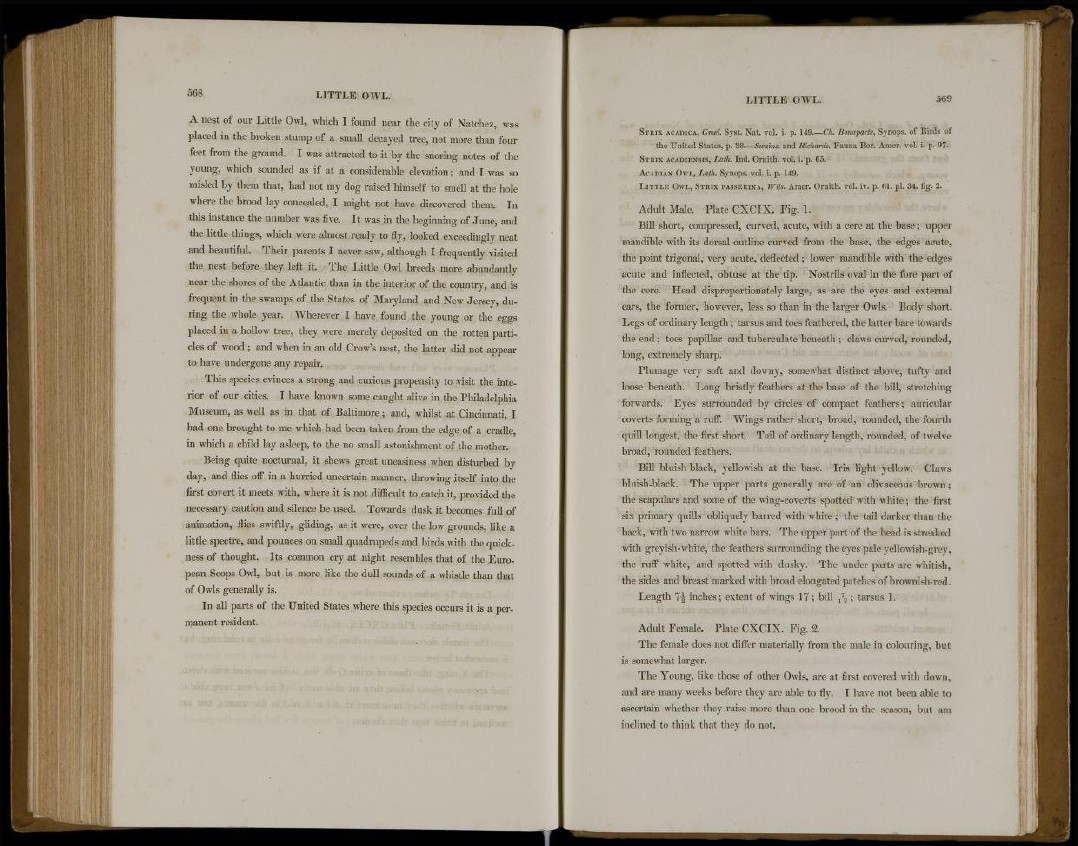
A nest of our Little Owl, which I found near the city of Natchez, was
placed in the broken stump of a small decayed tree, not more than four
feet from the ground. I was attracted to it by the snoring notes of the
young, which sounded as if at a considerable elevation; and I was so
misled by them that, had not my dog raised himself to smell at the hole
where the brood lay concealed, I might not have discovered them. In
this instance the number was five. It was in the beginning of June, and
the little things, which were almost ready to fly, looked exceedingly neat
and beautiful. Their parents I never saw, although I frequently visited
the nest before they left it. The Little Owl breeds more abundantly
near the shores of the Atlantic than in the interior of the country, and is
frequent in the swamps of the States of Maryland and New Jersey, during
the whole year. Wherever I have found the young or the eggs
placed in a hollow tree, they were merely deposited on the rotten particles
of wood; and when in an old Crow's nest, the latter did not appear
to have undergone any repair.
This species evinces a strong and curious propensity to visit the interior
of our cities. I have known some caught alive in the Philadelphia
Museum, as well as in that of Baltimore; and, whilst at Cincinnati, I
had one brought to me which had been taken from the edge of a cradle,
in which a child lay asleep, to the no small astonishment of the mother.
Being quite nocturnal, it shews great uneasiness when disturbed by
day, and flies off in a hurried uncertain manner, throwing itself into the
first covert it meets with, where it is not difficult to catch it, provided the
necessary caution and silence be used. Towards dusk it becomes full of
animation, flies swiftly, gliding, as it were, over the low grounds, like a
little spectre, and pounces on small .quadrupeds and birds with the quickness
of thought. Its common cry at night resembles that of the European
Scops Owl, but is more like the dull sounds of a whistle than that
of Owls generally is.
In all parts of the United States where this species occurs it is a permanent
resident.
STRIX ACADICA, Gmel. Syst. Nat. vol. i. p. 149—Ch. Bonaparte, Synops. of Birds of
the United States, p. 38—Swains, and Richards. Fauna Bor. Araer. vol. i. p. 97-
STRIX ACADIENSIS, Lath. Ind. Ornith. vol. i. p. 6 5 .
ACADIAN OWL, Lath. Synops. vol. i. p. 149.
LITTLE OWL, STRIX PASSERINA, Wils. Amer. Ornith. vol. iv. p. 61. pi. 34. fig. 2 .
Adult Male. Plate CXCIX. Fig. 1.
Bill short, compressed, curved, acute, with a cere at the base; upper
mandible with its dorsal outline curved from the base, the edges acute,
the point trigonal, very acute, deflected; lower mandible with the edges
acute and inflected, obtuse at the tip. Nostrils oval in the fore part of
the cere. Head disproportionately large, as are the eyes and external
ears, the former, however, less so than in the larger Owls. Body short.
Legs of ordinary length ; tarsus and toes feathered, the latter bare towards
the end; toes papillar and tuberculate beneath ; claws curved, rounded,
long, extremely sharp.
Plumage very soft and downy, somewhat distinct above, tufty and
loose beneath. Long bristly feathers at the base of the bill, stretching
forwards. Eyes surrounded by circles of compact feathers; auricular
coverts forming a ruff. Wings rather short, broad, rounded, the fourth
quill longest, the first short. Tail of ordinary length, rounded, of twelve
broad, rounded feathers.
Bill bluish black, yellowish at the base. Iris light yellow. Claws
bluish-black. The upper parts generally are of an olivaceous brown;
the scapulars and some of the wing-coverts spotted with white; the first
six primary quills obliquely barred with white; the tail darker than the
back, with two narrow white bars. The upper part of the head is streaked
with greyish-white, the feathers surrounding the eyes pale yellowish-grey,
the ruff white, and spotted with dusky. The under parts are whitish,
the sides and breast marked with broad elongated patches of brownish-red.
Length 7^ inches; extent of wings 17 ; bill ^ ; tarsus 1.
Adult Female. Plate CXCIX. Fig. 2.
The female does not differ materially from the male in colouring, but
is somewhat larger.
The Young, like those of other Owls, are at first covered with down,
and are many weeks before they are able to fly. I have not been able to
ascertain whether they raise more than one brood in the season, but am
inclined to think that they do not.